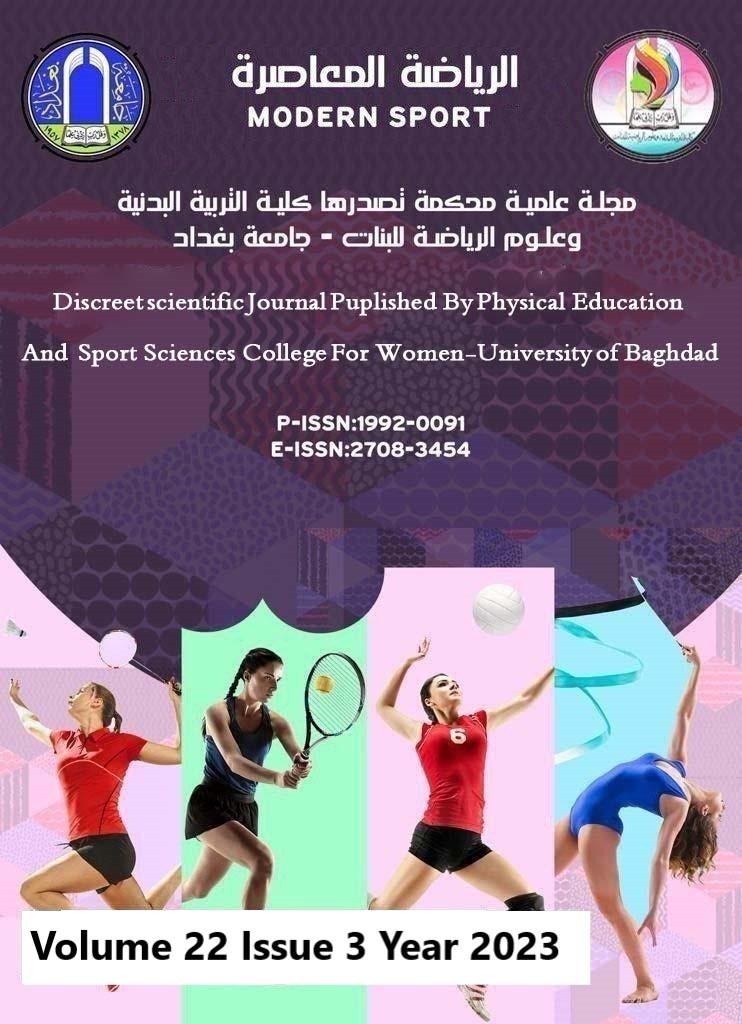The contribution percentage of the first (20) meters and the last (20) meters in the performance of elite sprinters in the (100, 200, 400) meter races
DOI:
https://doi.org/10.54702/ms.v22i3.1136Keywords:
Time contribution percentage, sprinters’ achievement in the (400, 200, 100) meters eventsAbstract
The sprint events (100, 200, 400) meters for men are considered among the most distinguished events in athletics. They require high levels of physical abilities and specialized motor skills, and certain bodily specifications. Similar to other sprinting events, performance in these events relies on a comprehensive application of technical aspects, and they significantly and effectively depend on the intermediate distances within them. The significance of the research stands out through continuous attention to athletic achievements and the ongoing process of their development. Additionally, it underscores the importance of kinetic analysis in identifying crucial weaknesses among sprinters. Furthermore, achieving optimal performance in the initial and final (20) meters is of utmost importance, as it can make a significant difference in the fastest races of track and field events. The cognitive problem of the study revolves around the question of the possibility of identifying the contribution percentage of the initial (20) meters and the final (20) meters to the final performance in the (100, 200, 400) meters. It focuses on the weak points sprinters encounter in achieving their optimal times for the required distances. The study aims to analyze these aspects and implement their applications to enhance athletic performance. Moreover, the study underscored the neglect of employing motion analysis to precisely identify weaknesses, as well as the lack of attention from coaches towards these value characteristics, so they can program their training routines to achieve their goals as quickly as possible with the least effort. The research aims to identify the numerical values of the time taken to cover the first (20) meters and the last (20) meters and the contribution percentage of these distances to the final performance. The researchers employed the descriptive method with a correlation relations approach and the contribution percentages due to its suitability to the nature of the study problem. The research population was selected from elite sprinters participating in the (400, 200, 100) meters. The total number of participants was (24) athletes who represented their respective clubs in the third round of the 2022 Club Championships. The research sample consisted of (12) athletes, with an average of (4) runners for each event selected randomly. The tests were conducted at the Al-Najaf International Stadium. The researchers used two (CASIO FH13.5) analysis cameras with a speed of 120 shots per second, and the analysis was done using the Kenova software. After analyzing and discussing the results, the researchers found a significant correlation between the time taken to cover the first and last (20) meters with the completion of (100) meters. There was also a correlation between the duration to traverse the first (20) meters with the completion of (200 and 400) meters. However, there was no correlation between the time taken to cover the last (20) meters with the completion of (200 and 400) meters. In light of this, the researchers recommend conducting extensive studies on these activities to identify the most critical weaknesses
References
Atheer Sabri, & Aqeel Al-Katib. (1980). Modern Circuit Training, Alaa Printing, Baghdad.p:123
Ahlam Al-Hasani. (2014). The effect of using special exercises on developing the level of physical fitness for sprinters. Modern Sport, 13(3), p:4. Retrieved from https://jcopew.uobaghdad.edu.iq/index.php/sport/article/view/257
Israa Fouad et al. (2014). The effect of using compound exercises for some types of speed on the development of the 200-meter run phases for junior sprints. Modern Sport, 13(4), p:5. Retrieved from
https://jcopew.uobaghdad.edu.iq/index.php/sport/article/view/248
Intisar Rashid Hamid. (2019). Analysis of momentary push-off indicators and foot positions at the start and takeoff moments and their relationship with the 100-meter sprint achievement for the Iraqi and Arab champions. Modern Sport, 12(20). P:16
https://jcopew.uobaghdad.edu.iq/index.php/sport/article/view/491
Jamila Najm Abdul Ridha & Ali Shaboot Ibraheem. (2020). The effect of special strength training Ahlam Shughati of working muscles during running on the development of some biomechanical variables and achievement 100m dash for youth. Journal of Physical Education, Vol. 32 No. 1. p:109
https://doi.org/10.37359/JOPE.V32(1)2020.975
Hachim Shani Awda et al. (2017). Modern Educational and Refereeing Foundations in Athletics. P:20
Hassan Nouri et al. (2017). Specific exercises using elastic bands and their effects on some physical and kinematic variables for 15-year-olds, and the partial distance time and achievement in 100m sprint for 14-year-olds. Modern Sport, 15(1), p:38. Retrieved from https://jcopew.uobaghdad.edu.iq/index.php/sport/article/view/89
Haider Abdul Ridha Al-Khafaji. (2014). Research in Psychology, Educational Methodologies, and Sciences. Baghdad, Al-Nuaimi. P:278
Risan Kharibet Majeed. Biochemical and Physiological Analysis in Sports Training. Baghdad, Dar Al-Hikma. P:299
Ruaa Amer Ismaeel & Bushra Kadhum Abdul-Ridha. (2022). The effect of critical speed exercises and mechanical ability to test the maximum speed of 400m runners under the age of 20 years. Modern Sport, 21(4), p:45.
https://doi.org/10.54702/ms.2022.21.4.0044
Sareeh Abdul Kareem Al-Fadli. (2010). Applications of Biomechanics in Sports Training and Performance, 1st Edition, Amman, Dar Dijla. P:74
Adil Hamid Al-Dulaimy. (2022). The effect of training with manufactured auxiliary tools on the development of explosive power, maximum speed, technical performance, and the achievement of a 100-meter run for youth. Modern Sport, 21(1), p:72.
https://doi.org/10.54702/msj.2022.21.1.0065
Ali Naeem & Sareeh Al-Fadhli. (2020). Special training according to centrifugal force law on some physical abilities in the second curve and achieving 400 m hurdlers. Journal of Physical Education, Vol. 32 No. 1. P:91
https://doi.org/10.37359/JOPE.V32(1)2020.973
Kaye Thorne and David Mackey. (2007). Everything You Want to Know About Training. (4th edition) Kogan Page, p:231
Mohamed Ali Ahmed Al-Qat. (1999). Functions of Exercise Physiology: An Applied Approach. Cairo, Dar Al-Fikr Al-Arabi. P:66
Maha Jamal & Iman Sabeeh. (2022). The relationship between the number of approximate sprint steps and the speed of the last three steps with the maximum torsion of the stick and the achievement of stick jumping for the Iraqi national team players. Modern Sport, 21(3), p:112.
https://doi.org/10.54702/msj.2022.21.3.0107
Nawar Maddada. (2018). Athletics 1, Arab Republic of Syria, Hama University/Faculty of Physical Education. P:33
Nawal Mahdi Al-Obaidi, Fatima Abd Maleh. (2012). Sports Training Science. University of Baghdad/ Physical Education and Sports Sciences College for Women. P:17
Widad Kadhum et al. (2016). The effect of plyometric training on improving positive acceleration phase and 100-meter sprint performance. Modern Sport, 15(3), p:9. Retrieved from https://jcopew.uobaghdad.edu.iq/index.php/sport/article/view/118
Downloads
Published
Issue
Section
License
Copyright (c) 2023 Modern Sport

This work is licensed under a Creative Commons Attribution 4.0 International License.















